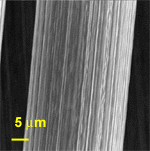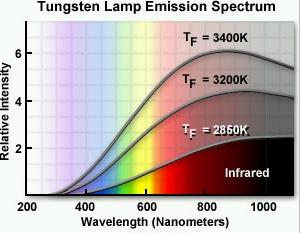Answer to the Question 03/01
INCANDESCENT LIGHTThe question was:
The "usual" incandescent light bulb operates in AC current. What is the size of the temperature oscillations of the filament of the bulb.
(5/02) The problem was solved (3/4/2002) by Regis Lachaume a Ph.D. student at Grenoble Observatory (France) (e-mail Regis.Lachaume@obs.ujf-grenoble.fr)). His solution can be found in the PDF file. A more "empirical" approach has been suggested (5/5/2002) by Szabolcs Galambosi from Department of Physics of University of Helsinki (Finland) (e-mail galambos@pcu.helsinki.fi)).
Answer: The temperature fluctuations will be about 80 K.
The solution:
A filament of a light bulb is formed by drawing tungsten metal into a very fine wire. The following figures show the close-up view of filament, with horizontal bar indicating the dimensions. Typical diameter of the wire is few tens of microns.


Relative ammount of radiation emitted at different wavelengths depend on the temperature of the body. The following graph shows the relative amounts of radiation at various wavelengths depending on the temperature of the filament. Notice, that even at the highest temperature depicted in this graph, most of the intensity is wasted in the invisible (heating) range of infra-red and larger wavelengths. Usually the tungsten light bulbs operate at 2800K temperature. From the point of view of producing visible light, even higher temperatures are needed, but at higher temperatures the filament evaporates too fast.

For the purpose of our calculation we will consider a L=0.7 meter long circular wire, D=30 microns in diameter. At (r.m.s.) voltage V=220 Volts, the power dissipated by such wire is
P=V2/R=V2{pi}D2/[4*L*{rho}=60 Watts,
where the resistance R has been calculated using specific resistance {rho}=8*10-7 Ohm*m at the temperature To=2800K.
We note that the power radiated by such a wire at this temperature is given by the Stefan-Boltzmann radiation law
Pr=p*S*sB*To4=60 Watts,
where we used tungsten emissivity p=0.28, and the Stefan-Boltzmann constant sB=5.64*10-8 Watt/[m2*K4], and the surface area S was calculated from the dimensions of the cylinder. [The fact that P=Pr indicates consistency of our choice of dimensions, although it should not be taken too literally, because the emissivity of the filament maybe actually smaller due to its geometry, and some of the heat is lost via heat conduction.] If we increase the length of the filament by factor b, and its diameter by factor b2, then the resistance will decrease by factor b3, while the power will increase by factor b3. Simultaneously, the surface area of the filament (to which the emission of light is proportional) will also increase by factor b3.
Let us assume that the only source of energy loss is radiation. Then, the change in the heat content (given by the l.h.s. of the equation below) will be equal to the difference between the heat produced by the current (first term on the r.h.s) and radiated heat (second term on r.h.s.).
C(dT/dt)=2(V2/R)cos2({omega}t)-p*S*sB*T4
where the heat capacity of the wire C can be calculate by multiplying the volume of the wire, by the mass density of tungsten 19.3*103kg/m3, and by specific heat 133 J/[kg*K] of tungsten. By averaging the above equation over time we can define the mean temperature of the filament To via relation
V2/R=p*S*sB*To4
If we assume that temperature fluctuations are very small, then we can neglect the fact that the second term in the r.h.s. includes temperature that is time dependent, and replace T by To. The equation, then becomes easily solvable, and its solution has the form
T=To+G*sin(2{omega}t),
where G is the amplitude of temperature fluctuations. Its value can be found by direct substitution into the equation, leading to
G=To/[2{omega}to], where to=C/p*S*sB*T03.
By substituting, the values of the parameters mentioned above we find that the "timescale" to=0.056 sec, and 2{omega}to=35. [We used the European current frequency of 50Hz.] Consequently, temperature fluctuation G=2800/35=80K.
Both Lachaume and Galambosi suggested an alternative approach to the problem. The approach began by an estimate of the time it takes to a bulb to cool off (assuming that it is approximately exponential decay in temperature). Galambosi convinced himself that the time is of order of 1 sec, since the afterglow of a lamp can be seen about that amount of time. From there he assume, that during quarter-period of oscillation of current (0.005 sec) the temperature will drop by 0.5%, i.e. by about 10K. Lachaumeme used similar argument, with much shorter estimate of decay time and concluded that the temperature oscillation should be larger than 50K. Note that our "timescale" in the above solution was 0.056 sec - a bit shorter than these intuitive estimates. Maybe somebody can actually perform this measurement, and tell us what is the experimental answer?!
 Back to "front page"
Back to "front page"